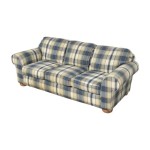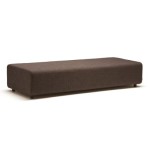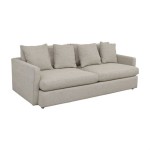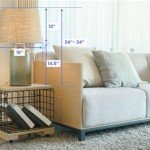How Much Does It Cost To Recover a Leather Sofa?
Recovering a leather sofa is a significant investment that can breathe new life into a cherished piece of furniture. Rather than replacing an old or worn leather sofa, reupholstering it offers an opportunity to customize the look, feel, and longevity of the piece. However, understanding the costs involved is crucial before embarking on this project. Several factors influence the final price, making it challenging to provide a single, definitive answer. This article will explore the various elements that determine the cost of recovering a leather sofa, providing a comprehensive overview to help homeowners budget effectively.
The cost of recovering a leather sofa is significantly influenced by the complexity of the design. A simpler design with straight lines and minimal detailing will generally be less expensive to recover compared to a sofa with intricate curves, tufting, or multiple cushions. These design elements require more specialized labor and a greater amount of fabric, subsequently increasing the overall cost.
The initial assessment of a leather sofa for recovery involves a thorough examination of its frame, suspension, and overall structure. The condition of these components can significantly impact the overall cost. If the frame is damaged, requiring repairs or reinforcement, this adds to the labor and material expense. Similarly, worn or broken springs in the suspension system need replacement, further contributing to the total cost.
Furthermore, the type and quality of the leather selected for the recovery process play a pivotal role in determining the overall expense. Different grades of leather vary significantly in price, durability, and aesthetic appeal. Opting for high-quality, full-grain leather will undoubtedly increase the cost compared to using a lower-grade, more processed leather. The quantity of leather required is also a factor, which is directly related to the size and design of the sofa.
Key Cost Factors: Type and Amount of Leather
The selection of leather is arguably the most significant factor when considering the cost of recovering a leather sofa. Leather is graded based on its quality, durability, and appearance. Full-grain leather, considered the highest quality, retains the natural grain of the hide and is known for its strength and character. Top-grain leather has had the top layer sanded or buffed to remove imperfections, resulting in a more uniform appearance but potentially reducing its durability. Corrected-grain leather undergoes more extensive processing, including embossing to create a consistent texture. Split-grain leather is the bottom layer of the hide and is often used for backing and lining.
The price per hide varies substantially depending on the grade. Full-grain leather can be significantly more expensive than corrected-grain or split-grain leather. Additionally, the source of the leather, such as domestically tanned or imported, can also affect its price. Leather from reputable tanneries with sustainable practices may command a higher premium.
The amount of leather needed depends on the size and design of the sofa. A large sectional sofa will obviously require more leather than a smaller loveseat. The complexity of the design also plays a role. Sofas with intricate curves, tufting, or multiple cushions necessitate more precise cutting and sewing, potentially increasing the amount of leather needed to account for waste. Professional upholsterers can accurately estimate the amount of leather required based on the sofa's dimensions and design.
Beyond the grade and quantity, the color and finish of the leather can also influence the cost. Certain dyes and finishes, particularly those that are custom-matched or require specialized application techniques, may add to the overall expense.
Labor Costs and Upholstery Expertise
Labor costs represent a substantial portion of the overall expense of recovering a leather sofa. Upholstery is a skilled trade that requires years of experience and specialized tools. The complexity of the project and the upholsterer's expertise will directly influence the labor charges.
Simple sofa designs with basic shapes and few details will generally require less labor time compared to more intricate designs. Sofas with tufting, piping, or complex stitching patterns demand more precision and time, resulting in higher labor costs. The process of removing the old fabric, making any necessary repairs to the frame or suspension, cutting and sewing the new leather, and reassembling the sofa requires a significant investment of time and skill.
The upholsterer's experience and reputation also play a role in determining labor costs. Highly skilled and experienced upholsterers may charge higher rates, but their expertise can ensure a higher quality finish and a longer lifespan for the recovered sofa. It is prudent to obtain quotes from multiple upholsterers and carefully review their portfolios and customer reviews before making a decision.
In addition to the standard upholstery work, additional services may also contribute to labor costs. These may include frame repairs, spring replacement, cushion filling replacement, or custom detailing. Discussing these potential additional costs with the upholsterer upfront is crucial to avoid any unexpected expenses.
Furthermore, the location of the upholstery shop can also affect labor costs. Upholstery shops in metropolitan areas with higher costs of living may charge higher rates compared to those in rural areas.
Additional Costs: Frame Repairs, Cushion Fillings, and Delivery
While the type of leather and labor costs are the primary drivers of the overall expense, several other factors can contribute to the final price. These include the condition of the sofa's frame, the need for cushion filling replacement, and delivery charges.
Before recovering a leather sofa, it is essential to assess the condition of the frame. Over time, the frame can become weakened due to wear and tear, requiring repairs or reinforcement. Common frame issues include loose joints, broken supports, and damaged legs. These repairs can add to the overall cost of the project.
Cushion fillings also require consideration. Over time, foam or feather fillings can lose their shape and support, compromising the comfort of the sofa. Replacing the cushion fillings with new high-density foam, down, or a combination of materials can significantly improve the comfort and appearance of the sofa. The cost of cushion filling replacement depends on the type of filling selected and the size and number of cushions.
Delivery charges should also be factored into the overall cost. Transporting the sofa to and from the upholstery shop may incur additional expenses. Some upholstery shops offer pick-up and delivery services, while others require the homeowner to arrange transportation. The distance and the size of the sofa will influence the delivery charges.
Other potential additional costs may include the replacement of buttons, zippers, or other hardware. If the existing hardware is worn or damaged, replacing it with new components can add to the final expense. Similarly, if the homeowner requests any custom detailing, such as piping or welting, this can also increase the cost.
Finally, it is important to inquire about any disposal fees associated with the removal of the old leather upholstery. Some upholstery shops may charge a fee for disposing of the old fabric, while others may include this cost in their overall estimate.
In essence, determining the cost of recovering a leather sofa requires a comprehensive assessment of various factors. The type and amount of leather, the complexity of the design, the labor costs, the condition of the frame, the need for cushion filling replacement, and delivery charges all play a role in the final price. By carefully considering these factors and obtaining quotes from multiple upholsterers, homeowners can make an informed decision and budget effectively for this significant investment. Obtaining detailed quotes and understanding the breakdown of costs is essential to ensuring a transparent and satisfactory experience.

Cost To Reupholster A Couch Save By Recovering We Can Fix That

Recover Your Sofa From Leather To Fabric Stunning Transformation And A Lot Er Than New Rescot Upholstery

Is It Worth To Reupholster A Sofa Seatup Llc

Leather Furniture Repair Couch Chair Restoration

Best Leather Dye For Couches Colors Restoration Supplies

Leather Furniture Repair Couch Chair Restoration

How Much Does It Cost To Reupholster A Sectional Sofa

Leather Upholstery Furniture Sofa Chairs Couches Ottomans Replace And Recover New Restuffing Sagging Broken Down Foam

Fixr Com Cost To Reupholster Couch Sofa Upholstery

Leather Sofa Repadding The Fast And Affordable Way To Give New Life Your Rescot Upholstery








